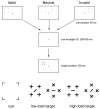Dissociation of visual C1 and P1 components as a function of attentional load: an event-related potential study
- PMID: 20599467
- PMCID: PMC2921581
- DOI: 10.1016/j.biopsycho.2010.06.008
Dissociation of visual C1 and P1 components as a function of attentional load: an event-related potential study
Abstract
The earliest cortical location at which attention influences visual processing is controversial. To address this issue, the C1 and P1 components of cue-elicited ERPs were examined in a spatially-cued task under high and low levels of attentional load (active vs. passive viewing). Cues were presented either to the left or to the right visual field in separate trials (unilateral presentation), or to both visual fields simultaneously (bilateral presentation). For the unilateral presentation, C1 (peak latency approximately 80 ms) was not modulated by attentional load, whereas P1 (peak latency approximately 120-140 ms) was larger for high-relative to low-load condition. Bilateral presentation of the stimuli enhanced the amplitude of the C1 component relative to unilateral presentation; however, the increase of signal/noise ratio of C1 revealed no attentional load effect on C1. Results show that attentional load modulates visual processing in the P1, but not in the C1 time range, regardless of the increased signal/noise ratio by bilateral presentation. While it remains unclear about the conditions under which a C1 attentional effect is reliably elicited, the present results suggest that the direct manipulation of attentional load under a voluntary attention task seems not crucial for eliciting C1 attentional effect.
Copyright (c) 2010 Elsevier B.V. All rights reserved.
Figures



Comment in
-
Voluntary attention reliably influences visual processing at the level of the C1 component: a commentary on Fu, Fedota, Greenwood, and Parasuram (2010).Biol Psychol. 2012 Oct;91(2):325-7; author reply 321-4. doi: 10.1016/j.biopsycho.2012.03.013. Epub 2012 Mar 23. Biol Psychol. 2012. PMID: 22483813 No abstract available.
Similar articles
-
Effect of temporal predictability on exogenous attentional modulation of feedforward processing in the striate cortex.Int J Psychophysiol. 2016 Jul;105:9-16. doi: 10.1016/j.ijpsycho.2016.04.007. Epub 2016 Apr 22. Int J Psychophysiol. 2016. PMID: 27114044
-
Early interaction between perceptual load and involuntary attention: An event-related potential study.Neurosci Lett. 2010 Jan 1;468(1):68-71. doi: 10.1016/j.neulet.2009.10.065. Epub 2009 Oct 27. Neurosci Lett. 2010. PMID: 19874869 Free PMC article.
-
Perceptual load interacts with involuntary attention at early processing stages: event-related potential studies.Neuroimage. 2009 Oct 15;48(1):191-9. doi: 10.1016/j.neuroimage.2009.06.028. Epub 2009 Jun 17. Neuroimage. 2009. PMID: 19539769 Free PMC article.
-
The experimental parameters that affect attentional modulation of the ERP C1 component.Cogn Neurosci. 2018 Jan-Apr;9(1-2):53-62. doi: 10.1080/17588928.2017.1369021. Epub 2017 Sep 8. Cogn Neurosci. 2018. PMID: 28826303 Review.
-
Evoked alpha and early access to the knowledge system: the P1 inhibition timing hypothesis.Brain Res. 2011 Aug 23;1408:52-71. doi: 10.1016/j.brainres.2011.06.003. Epub 2011 Jun 12. Brain Res. 2011. PMID: 21774917 Free PMC article. Review.
Cited by
-
Ensemble coding of multiple facial expressions is not affected by attentional load.BMC Psychol. 2024 Feb 27;12(1):102. doi: 10.1186/s40359-024-01598-9. BMC Psychol. 2024. PMID: 38414021 Free PMC article.
-
Multiple mechanisms link prestimulus neural oscillations to sensory responses.Elife. 2019 Jun 12;8:e43620. doi: 10.7554/eLife.43620. Elife. 2019. PMID: 31188126 Free PMC article.
-
Anatomic and functional asymmetries interactively shape human early visual cortex responses.J Vis. 2020 Jun 3;20(6):3. doi: 10.1167/jov.20.6.3. J Vis. 2020. PMID: 32503040 Free PMC article.
-
Perceptual load, voluntary attention, and aging: an event-related potential study.Int J Psychophysiol. 2012 Apr;84(1):17-25. doi: 10.1016/j.ijpsycho.2012.01.002. Epub 2012 Jan 14. Int J Psychophysiol. 2012. PMID: 22248536 Free PMC article. Clinical Trial.
-
Comparative analysis of early visual processes across presentation modalities: The event-related potential evoked by real-life, virtual reality, and planar objects.Cogn Affect Behav Neurosci. 2025 Aug;25(4):1022-1039. doi: 10.3758/s13415-025-01294-0. Epub 2025 Apr 8. Cogn Affect Behav Neurosci. 2025. PMID: 40199787 Free PMC article.
References
-
- Clark VP, Fan S, Hillyard SA. Identification of early visual evoked potential generators by retinotopic and topographic analyses. Human Brain Mapping. 1995;2:170–187.
-
- Clark VP, Hillyard SA. Spatial selective attention affects early extrastriate but not striate components of the visual evoked potential. Journal of Cognitive Neuroscience. 1996;8:387–402. - PubMed
-
- Di Russo F, Martinez A, Hillyard SA. Source analysis of event-related cortical activity during visuo-spatial attention. Cerebral cortex. 2003;13:486–499. - PubMed
-
- Driver J, Davis G, Ricciardelli P, Kidd P, Maxwell E, Baron-Cohen S. Gaze perception triggers reflexive visuospatial orienting. Visual cognition. 1999;6:509–540.
-
- Eimer M. The time course of spatial orienting elicited by central and peripheral cues: evidence from event-related brain potentials. Biological Psychology. 2000;53:253–258. - PubMed
Publication types
MeSH terms
Grants and funding
LinkOut - more resources
Full Text Sources

